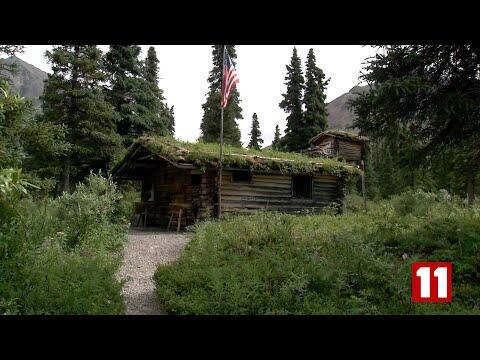By Rhonda McBride, KTVA.
I remember the first time I heard Dick Proenneke’s name, I said, “Dick, what?”
The name Proenneke, pronounced “preh’-neck-key,” sounded so odd.
My colleague Will Mader, our main Frontiers photojournalist, brought it up. He’s a big fan of Proenneke’s.
Will had devoured Proenneke’s journals and watched all his films. He had even made the pilgrimage to Dick’s cabin at Lake Clark National Park and Wilderness Preserve and talked with me about doing a show on efforts to preserve his log house.
Why? Alaska has lots of log cabins. Why this one?
Will convinced me this was an important story to tell.
Since Proenneke’s death in 2003, his fame has continued to grow. But curiously, he’s better known outside of our state than he is here, because his film, Alone is the Wilderness, is often featured in public broadcasting fundraisers across the country.
The more I learned, the more intrigued I became.
Proenneke, at the age of 52, went to Twin Lakes to reinvent himself, after a welding accident almost blinded him.
His mission: to find out if he had what it took to survive in the wilderness. He started by cutting down logs and used them to build a cabin, fashioned completely with hand tools – some that he made himself. Proenneke went on to live in his homemade house for more than 30 years — and through his journals and films became a famous wilderness advocate.
Will and I began our journey towards this week’s show more than two years ago, with a trip to Twin Lakes, where we had a chance to meet people who knew Dick Proenneke. It turned out to be what I call a Chinese box story, when you open one box, only to find another and another. There were plenty of surprises in those boxes – and we were left with an interesting collection.
Who was the real Dick Proenneke?
First and foremost, he aimed to leave his mark by treading lightly on the land, to have as little impact as possible on the wilderness he called home.
Although the country was remote, he discovered how fragile it was. He often spent his days picking up trash that hunters and pilots left behind.
Another facet of Dick Proenneke: he was a recycler extraordinaire, before the term was even widely used.
He would take discarded gas cans and turn them into cookware. He would salvage parts from airplane wrecks and fashion tools. He also made very user-friendly furniture, shaped to the curves of the body.
Dick Proenneke, we discovered, was many things to many people. That’s why we decided to create a special one-hour version of the show.
Here are some of the highlights:
• Dick Proenneke’s personal frontier: The story of how Dick Proenneke became a wilderness icon.
• Handmade home: Efforts to restore Dick Proenneke’s cabin at Twin Lakes.
• Keepers of the legacy, the journals: John Branson, a National Park Service historian based at Lake Clark talks about editing more than 90 pounds of Proenneke notebooks.
• Keepers of the legacy, the archive: Katie Myers, a curator for the National Park Service shows us the Dick Proenneke collection at the NPS archives in downtown Anchorage.
• Friends and neighbors: With help from the NPS and the Alaska Moving Image Preservation Association, a look at friendships Dick had with his nearest neighbors — Jay and Bella Hammond and the Alsworth Family.
• Wilderness princess: Former NPS ranger Patty Brown talks about her friendship with Dick Proenneke, who made her feel like “royalty.” How she came to hop off a float plane at Twin Lakes, wearing a black evening gown.
• Friends of Dick Proenneke and Lake Clark National Park: Fred Hirschmann shares his memories of Dick and talks about the need to protect and preserve the Proenneke homestead.
We have many, many people to thank for their help: John Branson and Katie Myers at the National Park Service, the Alsworth’s Lake Clark Air, the Hammond family, the Alaska Moving Image Preservation Association, Fred Hirschmann and the Friends of Dick Proenneke and Lake Clark National Park, and Bob Swerer Productions.
Perhaps the biggest joy of a project like this is all the friends you meet. We hope this show raises awareness about a great Alaskan, who is not well known in his own state. So here’s our attempt to change that.
Source
